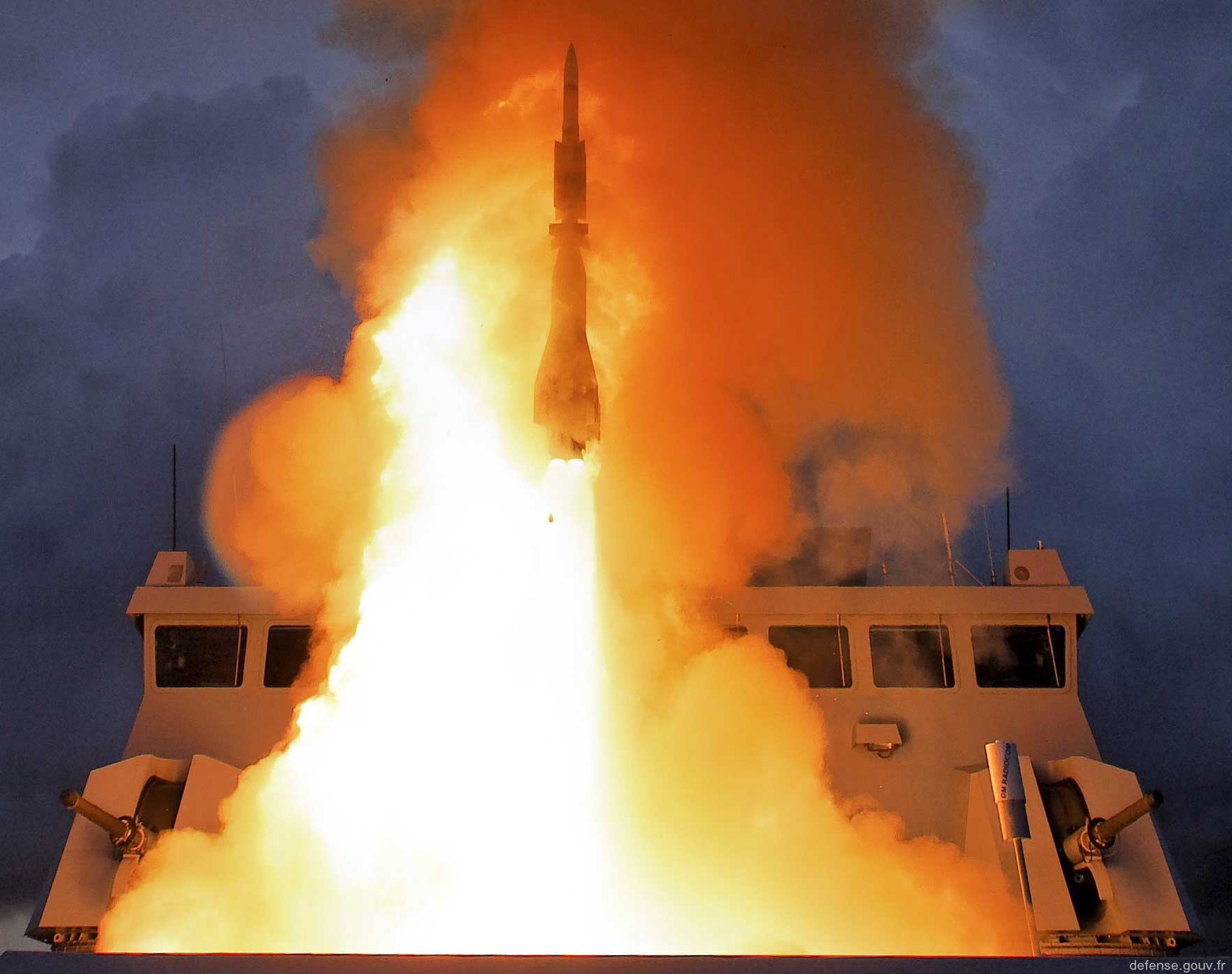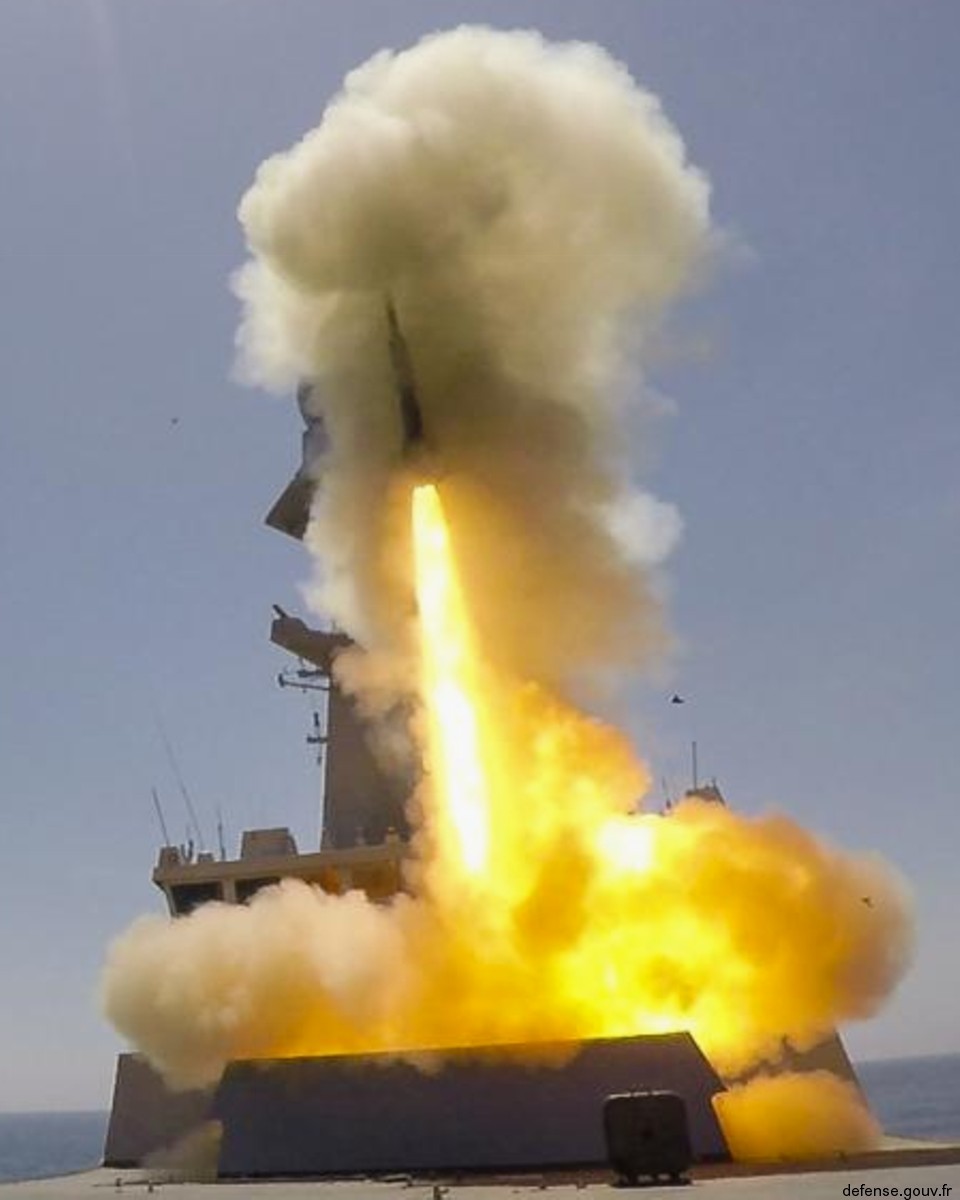 |
|
HOME
|
US Navy -
ships
|
US Navy - air
units
|
USMC - air
units
|
International
Navies
|
Weapon Systems
|
Special Reports |
|
Surface Vessel Weapon System MBDA Aster 15 / Aster 30 SAM |
 |
| 03/25 |
|
The Aster 15 and Aster 30 are a Franco-Italian family of
all-weather, vertical launch surface-to-air missiles. The name
"Aster" stands for "Aérospatiale Terminale", with French company
Aérospatiale having been the project's lead contractor before its
missile activities were merged into MBDA. It also takes inspiration
from the word "aster" (Greek: ἀστήρ), meaning "star" in Ancient
Greek. The missiles as well as the related weapon systems are
manufactured by Eurosam, a consortium consisting of MBDA France,
MBDA Italy and Thales, each holding a 33.3% share. The Aster missiles were developed to intercept and destroy the full spectrum of air threats from high-performance combat aircraft, UAVs and helicopters to cruise, anti-radiation and even sea-skimming supersonic anti-ship missiles. The Aster 30 Block 1 and Block 1 NT are designed to also counter ballistic missiles. The Aster is primarily operated by France and Italy, as well as the United Kingdom as an export customer, and is an integrated component of the PAAMS air defence system, known in the Royal Navy as Sea Viper. As the principal weapon of the PAAMS, the Aster equips the Horizon-class frigates in French and Italian service as well as the British Type 45 destroyers. It equips the French and Italian FREMM multipurpose frigates, though not through the PAAMS air defense suite itself but specific French and Italian derivatives of the system. Characteristics: There are two versions of the Aster missile family, the short-medium range version, the Aster 15, and the long range version, the Aster 30. The missile bodies are identical. Their difference in range and intercept speed is because Aster 30 uses a much larger booster. Total weights of the Aster 15 and Aster 30 are 310 kg (680 lb) and 450 kg (990 lb) respectively. The Aster 15 is 4.2 m (13 ft 9 in) long, rising to just under 5 m (16 ft 5 in) for the Aster 30. Aster 15 has a diameter of 180 mm (7.1 in). Given the larger dimensions of the Aster 30, a naval based system requires the longer tubes of the Sylver A50 or A70 vertical launching system (VLS). The American Mk. 41 Vertical Launching System can accommodate Aster 30. Variants: Aster 15: Short to medium range surface-to-air missile Aster 15 EC: New version of the Aster 15 with twice the range (60+ km); under development as of 2023 and expected to be introduced in 2030 Aster 30 Block 0: Medium to long range surface-to-air missile. It can pull manoeuvres in excess of 50g. Aster 30 Block 1: Variant with anti-ballistic missile capability; tailored to counter 600 km (370 mi)-class short-range ballistic missiles. Aster 30 Block 1NT: NT standing for "New Technology", it is a new variant of the Aster 30 designed to counter short and 1,500 km (930 mi)-class medium-range ballistic missiles. Aster 30 Block 2 BMD: Anti-ballistic missile under development and intended to counter up to 3,000 km (1,900 mi)-class ballistic and maneuvering missiles. The Aster 30 Block 1 is used on the Eurosam SAMP/T system operated by the French Air and Space Force and the Italian Army. In 2015, France launched the development of the Block 1NT variant, a programme Italy would join in 2016. The same year, the United Kingdom showed interest in acquiring the Block 1NT version for its Type 45 destroyers currently operating the Block 0. In 2022, the United Kingdom announced a series of upgrades to its Type 45 destroyers. This included the implementation of the Block 1 version for anti-ship ballistic missile defense. Land based systems: The Aster 30 has been incorporated by Eurosam into a mobile SAM system, fulfilling the ground-based theatre air defence/protection requirement. It comes in the form of the Sol-Air Moyenne-Portée/Terrestre (French for "Surface-to-Air Medium-Range/Land-based"), abbreviated as SAMP/T. The system uses a network of radars and sensors - including 3D phased array radar – enabling it to be effective against various air threats such as aircraft, tactical ballistic missiles, standoff missiles, cruise missiles or anti-radiation missiles. The SAMP/T uses an upgraded version of the Arabel long range radar, developed under the Aster 30 Block 1 upgrade program, in order to extend the system's capability against higher speed and higher altitude targets. The Aster 30 Block 1 can intercept missiles with a 600 km (370 mi) range (short-range ballistic missiles). SAMP/T NG uses either the Kronos Grand Mobile High Power or the Ground Fire 300 AESA radars. SAMP/T NG will be delivered from 2025. Specifications: ASTER 15 Diameter: 180 mm (7.1 in) Wingspan: 79 cm (2 ft 7 in) - booster / 36 cm (1 ft 2.2 in) - missile Length: 4.2 m (13 ft 9 in) Mass: 310 kg (683 lb) Operational Range: > 30 km (16.25 nmi) Flight altitude: 13,000 m (42,650 ft) Maximum speed: Mach 3 (1,029 m/s; 3,376 ft/s / 3,700 km/h) ASTER 30 Diameter: 180 mm (7.1 in) Wingspan: 79 cm (2 ft 7 in) - booster / 36 cm (1 ft 2.2 in) - missile Length: 4.9 m (16 ft 1 in) Mass: 450 kg (992 lb) Operational Range: Block 0 + 1 = > 120 km (65 nmi) / Block 1NT = > 150 km (81 nmi) Flight altitude: Block 0 + 1 = 20 km / Block 1NT = 25 km Maximum speed: Mach 4.5 (1,400 m/s; / 5,000 km/h) Common: Warhead: 15 kg focused fragmented warhead with 2 m lethal radius Detonation mechanism: calculated delay proximity fuze Engine: Solid propellant, two-stage motor Guidance: Inertial guidance with up-link / Active RF seeker Manufacturer: MBDA sources: MBDA, wikipedia |
| images |
 Aster 15  Aster 30  an Aster 15 was fired from a Royal Navy Type 45 / Daring class Guided Missile Destroyer  an Aster 15 was fired from a Royal Navy Type 45 / Daring class Guided Missile Destroyer  an Aster 15 was fired from a Royal Navy Type 45 / Daring class Guided Missile Destroyer  an Aster 15 was fired from a Royal Navy Type 45 / Daring class Guided Missile Destroyer  an Aster 15 was fired from a Royal Navy Type 45 / Daring class Guided Missile Destroyer  an Aster 15 was fired from a Republic of Singapore Navy Formidable class Frigate  an Aster 15 was fired from a Republic of Singapore Navy Formidable class Frigate  an Aster 15 was fired from a Republic of Singapore Navy Formidable class Frigate  an Aster 15 was fired from a Republic of Singapore Navy Formidable class Frigate  an Aster 15 was fired from a Republic of Singapore Navy Formidable class Frigate  Aster 30  an Aster 30 was fired from a French Marine Nationale Aquitaine / FREMM class Frigate  an Aster 30 was fired from a French Marine Nationale Aquitaine / FREMM class Frigate  an Aster 30 was fired from a French Marine Nationale Aquitaine / FREMM class Frigate  an Aster 30 was fired from a French Marine Nationale Aquitaine / FREMM class Frigate  Aster 15 and Aster 30 size comparison  Aster 30 was fired from a SAMP/T ground based missile system  Aster 30 was fired from a SAMP/T ground based missile system  Aster 30 was fired from a SAMP/T ground based missile system  Aster 30 was fired from a SAMP/T ground based missile system |
|
|
seaforces.org
|
Weapon Systems
start page
| |